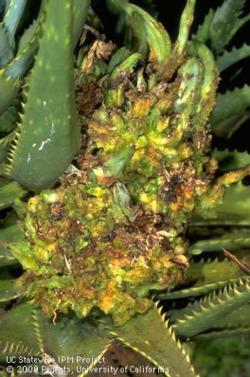Spring 2010: Integrated pest management of the aloe mite
Regional Report San Diego and Riverside Counties by James A. Bethke

Some pests are unique and very difficult to manage, and it can be quite a challenge to develop an integrated pest management program for them. The aloe mite, Eriophyes aloinis (Keifer), is a good example. There is almost nothing known about this mite because it is one of the smaller Eriophyid mites (rust mites or gall mites). To see these mites it usually takes at least 60x magnification on a stereomicroscope, so studying their biology and behavior is very difficult. In addition, there are few miticides that work well on Eriophyids.
Because aloe is becoming more popular in San Diego County ornamental production facilities, we have begun studying the biology, phenology and control of the aloe mite and the susceptibility of selected aloe varieties in preparation for the development of an integrated pest management program for this pest.
There are about 500 or so varieties of aloes worldwide, and they are in ever-increasing demand due to low maintenance requirements and drought tolerance; there are more attractive varieties being developed for commercial sale all the time. In addition, with the increasing interest in promoting fire-retardant landscapes in San Diego County, aloe is recommended as one of the alternative plants to traditional landscapes. These attributes make aloes very attractive to consumers looking for alternative plants for low maintenance gardens and landscape plantings.
The aloe mite causes tumor-like growths on aloe and is commonly referred to as aloe cancer. The development of this deformed tissue makes aloe plants aesthetically unappealing and unsalable, and unfortunately, the damage is irreversible. The only curative solution is the removal of the infected plant parts, which is also necessary to prevent further spread of the mite.
In commercial aloe plantations where the plant is processed for use in medicines and cosmetics, recommended cultural practices include the removal of the affected part of the plant and the application of miticides. The yield of the plant is not greatly reduced by these practices. However, in the ornamental industry, the damage caused by the mite is aesthetic and is of great economic importance. Once the plants are affected, they lose commercial value, representing a total loss for the grower.
At present, management practices lead to significant losses and to a wait and see approach to control. The basis for a good management practice against E. aloinis is to develop a life history of the pest and determine the actual number of mites that can cause significant damage to the plants. In addition to the alternative methods of control, it is critical to know which miticides are most effective against the pest and whether curative or preventative approaches will be the best practice.
Our goal is to provide important information required for implementing best management practices and integrated pest management strategies. Studies will include seasonal incidence, critical mite levels capable of inducing galls, and the efficacy of several miticides as curative and preventive control methods. In addition, our work will be a critical addition to the current scientific knowledge of E. aloinis and its relationship to aloe.












